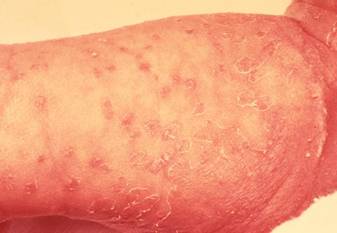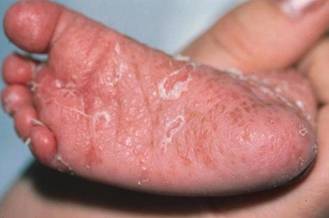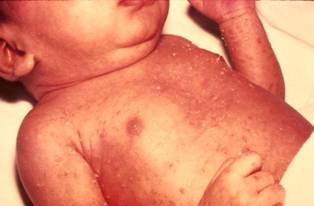Fungal
There is fungus among us
Dermatophytes are fungi that have the ability to live on the keratin of hair nails and skin. Fungal infections are classified according to their location on the patient rather than by the causative organism.
Tinea capitis
Tinea capitis is a dermatophytic infection of the scalp. Clinical presentation varies from mild scaling and broken-off hairs to a more rare but severe, painful inflammation with painful, boggy nodules that drain pus and result in scarring alopecia.
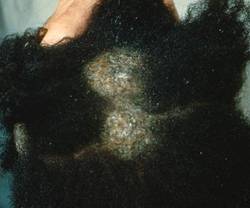
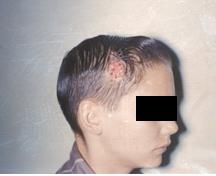
Tinea corporis
Tinea corporis refers to dermatophyte infection of the trunk, legs, arms, and neck. It presents as small to large, scaling, plaques with or without pustules or vesicles at the clearly defined, elevated, margins.
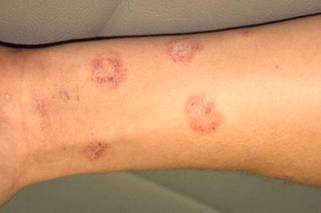
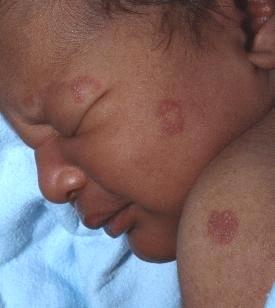
More Info: Tinea corporis
Tinea pedis
Tinea pedis, aka "athlete's foot," is a dermatophytic infection of the feet characterized by erythema, scaling, maceration, and bulla formation. Tinea pedis can lead to secondary infections with Staphylococcus aureus or group A Streptococcus.
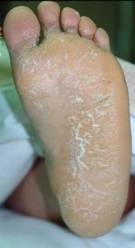
Tinea cruris
Tinea cruris, aka "jock itch," is a subacute or chronic dermatophytosis of the groin, pubic regions and thighs. It presents as large, scaling, well-demarcated plaques with or without central clearing. It usually spares the scrotum.
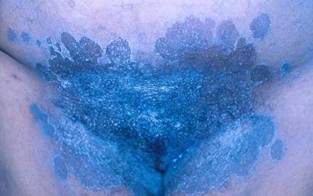
More Info: Jock Itch (tinea cruris)
Tinea versicolor
Tinea versicolor, aka pityriasis veriscolor, is a chronic, asymptomatic scaling dermatosis found on the neck, oily areas on the trunk such as the chest, upper back, and shoulders, or upper arms. It is associated with the superficial overgrowth of the hyphal form of Pityrosporum ovale (aka Malassezia furfur). It presents as well-demarcated macules or patches with hypopigmentation or hyperpigmenation and fine scale and occurs most commonly on the trunk.
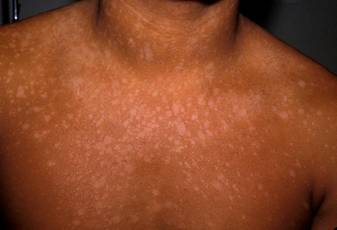
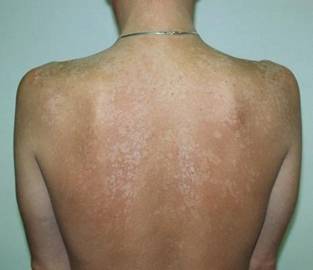
More Info: Tinea versicolor (pityriasis versicolor)
Cutaneous candidiasis
Cutaneous candidiasis occurs on moist, occluded skin, but presents very differently depending upon the sites involved, the duration of the infection, and the immune status of the host. Most sites of infection have a "beefy red" erythema and superficial pustules with satellite red papules.
- Superficial infections of the mucosal surfaces of the oropharynx and genitalia are common in otherwise healthy individuals.
- Candida intertrigo presents as superficial pustules, erythema, edema, creamy exudates with skin folds.
- Thrush exhibits white, adherent, cottage-cheese-like plaques on oral mucosa.
- Perleche manifests as erythema, fissuring, and creamy exudates at the angles of the mouth.
- Diaper dermatitis demonstrates "beefy red" erythema with elevated margins and satellite red plaques. Erythematous erosions, papules, and vesicles are also found in diaper dermatitis.
- Congenital candidiasis presents in the newborn as generalized erythema with scaling and papules which progressed to pustules followed by crusting and desquamation.
- Invasive, disseminated candidiasis occurs in immunocompromised individuals, including some newborns.
